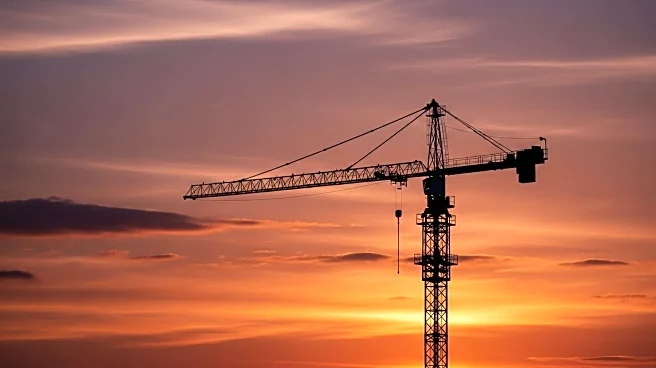What's Happening?
Nonresidential construction spending in the United States decreased by 0.2% in July, as reported by the Associated Builders and Contractors (ABC) based on data from the U.S. Census Bureau. The seasonally adjusted annualized spending reached $1.24 trillion. This marks the third consecutive month of decline, with spending down 2.5% from the record high in December 2023. The decrease was observed in 7 of the 16 nonresidential subcategories, with private nonresidential spending falling by 0.5% and public nonresidential construction spending rising by 0.3%. ABC Chief Economist Anirban Basu highlighted the impact of rising construction material prices and higher tariff rates, which have exacerbated the decline in construction activity. Private nonresidential activity has been particularly affected, with only the religious and power categories showing some resilience.
Why It's Important?
The decline in nonresidential construction spending is significant as it reflects broader economic challenges facing the construction industry. Rising material costs and tariffs are contributing to project interruptions and cancellations, affecting nearly 25% of ABC members according to their Construction Backlog Indicator survey. This situation is compounded by economic uncertainty, labor shortages, and increasing material prices, which could lead to a challenging second half of the year for the industry. The construction sector is a key component of the U.S. economy, influencing employment and economic growth. The ongoing issues may impact infrastructure development and investment, potentially slowing down economic recovery efforts.
What's Next?
The construction industry may face continued challenges as higher import taxes, implemented in early August, further strain project budgets. Stakeholders in the industry, including contractors and suppliers, will need to navigate these economic pressures while addressing labor shortages and rising costs. The ABC's Construction Backlog Indicator and Construction Confidence Index will provide ongoing insights into industry trends and potential recovery paths. Policymakers may need to consider measures to alleviate tariff impacts and support the construction sector to stabilize the market.
Beyond the Headlines
The decline in construction spending highlights the broader implications of trade policies and economic uncertainty on the industry. The rising costs of materials due to tariffs may prompt discussions on trade policy adjustments and economic strategies to support domestic industries. Additionally, the labor shortages in construction could lead to increased focus on workforce development and training programs to ensure a skilled labor pool is available to meet future demands.













